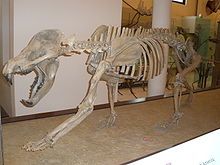Bear dogs
| Amphicyonidae Temporal range: 46.2–1.8 Ma Middle Eocene - |
|
|---|---|
 |
|
| Skeleton of Amphicyon | |
| Scientific classification | |
| Kingdom: | Animalia |
| Phylum: | Chordata |
| Class: | Mammalia |
| Order: | Carnivora |
| Suborder: | Caniformia |
| Family: |
†Amphicyonidae Haeckel, 1886 |
| Subfamilies | |
|
|
Amphicyonidae is an extinct family of large terrestrial carnivorans belonging to the suborder Caniformia which inhabited North America, Europe, Asia, and Africa from the Middle Eocene subepoch to the epoch 46.2—1.8 Mya, existing for about 44.4 million years. Amphicyonids are often colloquially referred to as "bear-dogs", but are more closely related to true dogs (Canidae) than to bears (Ursidae).
The family was erected by Haeckel (1886) [also attributed to Trouessart 1885]. While amphicyonids were previously thought to be closely related to ursids (bears), there is increasing evidence that they may be basal caniforms.
Amphicyonids ranged in size from as small as 5 kg (11 lb) and as large as 100 to 600 kg (220 to 1,320 lb) and evolved from wolf-like to bear-like body forms. Early amphicyonids, such as Daphoenodon, possessed a digitigrade posture and locomotion (walking on their toes), while many of the later and larger species were plantigrade or semiplantigrade. The amphicyonids were obligate carnivores, unlike the Canidae, which are hypercarnivores or mesocarnivores.
There is often some confusion with the similar looking (and similarly named) "dog-bears", which are members of the family Hemicyonidae.
...
Wikipedia
